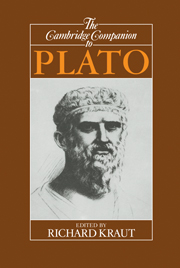Book contents
- Frontmatter
- 1 Introduction to the study of Plato
- 2 Plato
- 3 Stylometry and chronology
- 4 Socrates and the early dialogues
- 5 Mathematical method and philosophical truth
- 6 Inquiry in the Meno
- 7 Plato and Greek religion
- 8 Platonic love
- 9 Plato's metaphysical epistemology
- 10 The defense of justice in Plato's Republic
- 11 Plato on poetic creativity
- 12 Good-bye to the Third Man
- 13 Plato's Sophist on false statements
- 14 Disintegration and restoration
- 15 Plato's later political thought
- Bibliography
- Index
3 - Stylometry and chronology
Published online by Cambridge University Press: 28 May 2006
- Frontmatter
- 1 Introduction to the study of Plato
- 2 Plato
- 3 Stylometry and chronology
- 4 Socrates and the early dialogues
- 5 Mathematical method and philosophical truth
- 6 Inquiry in the Meno
- 7 Plato and Greek religion
- 8 Platonic love
- 9 Plato's metaphysical epistemology
- 10 The defense of justice in Plato's Republic
- 11 Plato on poetic creativity
- 12 Good-bye to the Third Man
- 13 Plato's Sophist on false statements
- 14 Disintegration and restoration
- 15 Plato's later political thought
- Bibliography
- Index
Summary
For a correct understanding of Plato, account needs to be taken of the fact that his philosophical activity spanned some fifty years, during which time certain doctrines underwent considerable changes. To trace this development and so be able to identify the final expression of his thought, it is essential to know in what order the dialogues were written, but there is little help in this quest either from external sources or from the dialogues themselves. Regarding the former, the only information likely to be reliable is Aristotle's statement that the Laws was written after the Republic. This is repeated by Diogenes Laertius (III 37) and Olympiodorus [Prol. VI 24), who add that the Laws was still in an unrevised state on wax tablets when Plato died and was published posthumously by one of his students, Philip of Opus. As for internal evidence, cross references in the Sophist (217a) and Politicus (257a, 258b) indicate the prior composition of the former, while the Timaeus (27a) mentions the Critias as its sequel. Rather less definite is the apparent reference in the Timaeus (17b- 19b) to the Republic, in the Sophist to the Parmenides (217c) and Theaetetus (216a), and in the Theaetetus to the Parmenides (183e).
- Type
- Chapter
- Information
- The Cambridge Companion to Plato , pp. 90 - 120Publisher: Cambridge University PressPrint publication year: 1992
- 19
- Cited by

